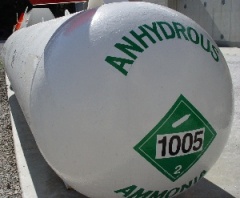Difference between revisions of "Ammonia (anhydrous)"
From Cargo Handbook - the world's largest cargo transport guidelines website
(Created page with "{{Infobox_Forest | image = Ammonia_(anhydrous).jpg | origin = forest | stowage factor = | humidit...") |
|||
| Line 1: | Line 1: | ||
{{Infobox_Forest | {{Infobox_Forest | ||
| image = Ammonia_(anhydrous).jpg | | image = Ammonia_(anhydrous).jpg | ||
| − | | origin = | + | | origin = - |
| − | | stowage factor = | + | | stowage factor = <lu><li>0.86 kg/m<sup>3</sup> (1.013 bar at boiling point)</li><li>0.73 kg/m<sup>3</sup> (1.013 bar at 15°C)</li><li>681.9 kg/m<sup>3,</sup> at −33.3°C (liquid)}}[1]</li>817 kg/m3 at −80°C (transparent solid)</li> |
| + | |||
| humidity and moisture = | | humidity and moisture = | ||
| ventilation = | | ventilation = | ||
| risk factors = | | risk factors = | ||
}} | }} | ||
Revision as of 13:43, 3 October 2012
| Infobox on Ammonia (anhydrous) | |
|---|---|
| Example of Ammonia (anhydrous) |  |
| Facts | |
| Origin | - |
| Stowage factor (in m3/t) | <lu> |
| Humidity / moisture | {{{humidity and moisture}}} |
| Ventilation | {{{ventilation}}} |
| Risk factors | {{{risk factors}}} |
Ammonia (anhydrous)
Contents
| humidity and moisture = | ventilation = | risk factors = }}











